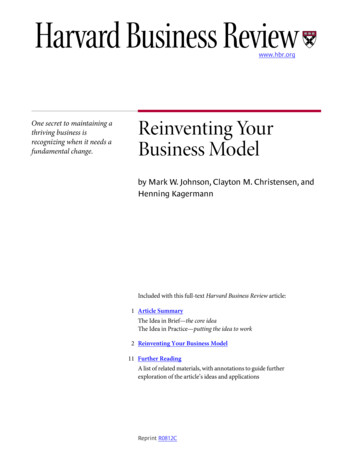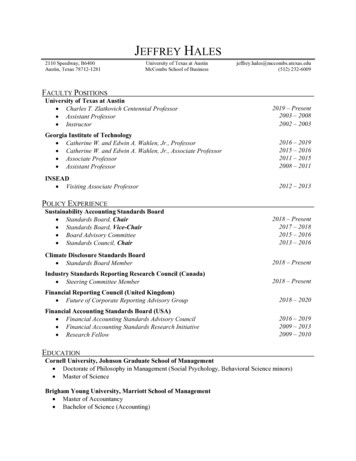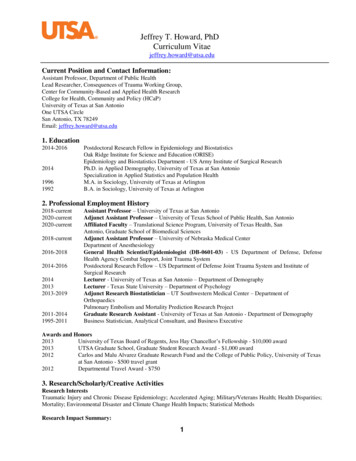
Transcription
Are You Caught in a "Lifetrap"?Are you drawn into relationships with peoplewho are selfish or cold?Are you afraid of showing other people who you really are,because you think they might reject you?Do you feel inadequate compared to people around you?Do you sacrifice relaxation and fun because you'realways trying to do your best?Let two of America's leading psychologists show youhow to free yourself from these destructive"lifetraps" with exciting, breakthrough techniquesthat can transform your life.Jeffrey E. Young, PH.D., is founder and director of the Cognitive TherapyCenters of New York and Fairfield County (Connecticut), as well as a facultymember in the Department of Psychiatry at Columbia University. Dr. Young isan internationally recognized lecturer on cognitive therapy. He lives in Wilton,Connecticut.Janet S. Klosko, PH.D., commutes between Kingston, New York, where she hasa private practice, and Great Neck, New York, where she is codirector of theCognitive Therapy Center of Long Island.
3PLUMEPublished by the Penguin GroupPenguin Group (USA) Inc., 375 Hudson Street, New York, New York 10014, U.S.A.Penguin Group (Canada), 90 Eglinton Avenue East, Suite 700, Toronto, Ontario,Canada M4P 2Y3 (a division of Pearson Penguin Canada Inc.)Penguin Books Ltd., 80 Strand, London WC2R ORL, EnglandPenguin Ireland, 25 St. Stephen's Green, Dublin 2, Ireland(a division of Penguin Books Ltd.)Penguin Group (Australia), 250 Camberwell Road, Camberwell, Victoria 3124,Australia (a division of Pearson Australia Group Pty. Ltd.)Penguin Books India Pvt. Ltd., 11 Community Centre, Panchsheel Park,New Delhi ‐110 017, IndiaPenguin Group (NZ), 67 Apollo Drive, Rosedale, North Shore 0632, New Zealand(a division of Pearson New Zealand Ltd.)Penguin Books (South Africa) (Pty.) Ltd., 24 Sturdee Avenue, Rosebank,Johannesburg 2196, South AfricaPenguin Books Ltd., Registered Offices: 80 Strand, London WC2R ORL, EnglandPublished by Plume, a member of Penguin Group (USA) Inc.Previously published in a Dutton edition.First Plume Printing, May 199439 38 37 36 35Copyright Jeffrey E. Young and Janet S. Klosko, 1993All rights reservedREGISTERED TRADEMARK—MARCA REGISTRADALIBRARY OF CONGRECC CATALOGING‐IN‐PUBLICATION DATAYoung, Jeffrey E.Reinventing your life : the breakthrough program to end negative behavior . and feel great againp. cm.ISBN 978‐0‐452‐27204‐01. Self‐defeating behavior. 2. Self‐management (Psychology). l. Klosko, Janet S.II. Title.[RC455.4.S43Y68 1994]158'.1—dc2093‐48711CIPPrinted in the United States of AmericaWithout limiting the rights under copyright reserved above, no part of this publication may bereproduced, stored in or introduced into a retrieval system, or transmitted, in any form, or by anymeans (electronic, mechanical, photocopying, recording, or otherwise), without the prior writtenpermission of both the copyright owner and the above publisher of this book.PUBLISHER'S NOTEThe scanning, uploading, and distribution of this book via the Internet or via any other meanswithout the permission of the publisher is illegal and punishable by law. Please purchase onlyauthorized electronic editions, and do not participate in or encourage electronic piracy ofcopyrighted materials. Your support of the author's rights is appreciated.BOOKS ARE AVAILABLE AT QUANTITY DISCOUNTS WHEN USED TO PROMOTE PRODUCTS OR SERVICES. FOR INFORMATIONPLEASE WRITE TO PREMIUM MARKETING DIVISION, PENGUIN GROUP (USA) INC., 375 HUDSON STREET, NEW YORK10014.
4For Manny, Ethel, and Hannes, who have lovedand supported me unconditionally.—JEFFREY YOUNGFor my mother, father, Michael, and Molly, whoall gave me the space to write this book.—JANET KLOSKO
5AcknowledgementsReinventing Your life has special meaning. This book represents the culmination ofyears of personal and professional growth for each of us. For this reason, we havemany people to thank, past and present, who have in some important waycontributed to our development.We are indebted to Dan and Tara Goleman, without whose guidance, faith,advice, gentle prodding, and of course, friendship, we would never have undertakensuch an overwhelming project; to Arthur Weinberger, for his suggestions andencouragement during many years of developing the schema‐focused model; toWilliam Zangwill, who, in his invaluable role as devil's advocate and critic, has inspiredus to sharpen and refine our ideas; to 'David Bricker, who, through his involvement innew approaches to psychotherapy, continually offers us fresh perspectives toconsider; to Cathy Flanagan, for her help in running the Center, her intelligentcomments, and her warmth; to Bill Sanderson, who has played an important role asDirector of Training at the Cognitive Therapy Center of New York and as co‐director atthe Cognitive Therapy Center of Long Island; to Marty Sloane, Richard Sackett, JayneRygh, and all our other friends and colleagues in New York who have contributed tothe development of this approach; and to our editors Deb Brody and AlexiaDorszynksi, who helped give the book its form and tone, and to our agent PamBernstein, who helped make the book possible.—JY and JKI would like to extend my personal thanks to several other people who have playedimportant roles in my development. To Janet Klosko, for making this collaboration sostimulating and fruitful. I could not have "reinvented" anyone better to work with; toWill Swift, who, like my father, has always had supreme confidence in me, even whenI was not so sure—thank you for helping me get my ideas on tape, and for providingcrucial feedback over the past eight years; to Aaron (Tim) Beck, who, through hisclinical wisdom, penetrating intelligence, and empirical approach to personal andprofessional problems, has served as my mentor. To Peter Kuriloff and Arthur Dole,my graduate school advisors, for their friendship, for having confidence in me, andfor being open enough to give me the freedom to pursue cognitive therapy before itwas widely accepted; to Candice, for putting up with me and for her devotion inshouldering much of the responsibility I cannot handle; to Richard and DianeWattenmaker, Bob Spitzer, Janet Williams, Gene D'Aquili, and many others who havecontributed in ways they probably do not realize.I have been fortunate throughout my life to have a family that I can always relyon for praise, reassurance, and acceptance, regardless of what I have gone throughpersonally. For accepting all my quirks, I would like to thank my parents,grandparents, brother Stephen, sister Debra, and the other members of my extended
6family. I have learned through working with patients less fortunate than I not to takesuch support for granted.—JYI would like to thank all the other people who helped me become the psychologistthat I am. I would like to start by thanking Jeff Young, for being such an exemplarymodel, and for giving me the best form of therapy I have ever known. I would like tothank my mentor, David Barlow, for teaching me the meaning of the word"professional," and for encouraging me to fulfill my talents. I would like to thank mysupervisor in New York City, Will Swift; Ann De Lancey, Mike Burkhardt, and myfellow interns and other advisors from Brown University; and from SUNY at Albany—Jerry Cerny, Rick Heimberg, John Wapner, Glen Conrad, Robin Tassinari, JimMancuso, Robert Boice, Bill Simmons, Alan Cohen, my warm supportive classmates,and others. Finally, I would like to thank the other members of my family and closefriends, for everything they have given me.—JK
7ContentsAcknowledgements. 5Foreword by Aaron Beck, M.D. . 8Preface . 1001 ‐ Lifetraps . 1302 ‐ Which Lifetraps Do You Have? . 2303 ‐ Understanding Lifetraps. 3104 ‐ Surrender, Escape, and Counterattack. 4105 ‐ How Lifetraps Change . 4706 ‐ The Abandonment Lifetrap. "Please Don't Leave Me!" . 6007 ‐ The Mistrust and Abuse Lifetrap. "I Can't Trust You" . 8008 ‐ The Emotional Deprivation Lifetrap. "I'll Never Get the Love I Need" . 10109 ‐ The Social Exclusion Lifetrap. "I Don't Fit In" . 11810 ‐ The Dependence Lifetrap. "I Can't Make It on My Own" . 13911 ‐ The Vulnerability Lifetrap. "Catastrophe Is About to Strike" . 16312 ‐ The Defectiveness Lifetrap. "I'm Worthless". 18213 ‐ The Failure Lifetrap. "I Feel Like Such a Failure". 20814 ‐ The Subjugation Lifetrap. "I Always Do It Your Way!" . 22315 ‐ The Unrelenting Standards Lifetrap. "It's Never Quite Good Enough" . 25216 ‐ The Entitlement Lifetrap. "I Can Have Whatever I Want" . 26917 ‐ A Philosophy of Change . 291References . 300
8Forewordby Aaron Beck, M.D.I am delighted that Jeffrey Young and Janet Klosko have tackled the difficult issue ofpersonality problems, drawing upon the techniques and principles of cognitivetherapy. The authors have done pioneering work in developing and making availableto the public a powerful set of tools for making significant life changes inrelationships and at work.Personality disorders are self‐destructive, lifelong patterns that bring patientstremendous unhappiness. People with personality disorders have long‐termproblems with living, in addition to specific symptoms like depression and anxiety.They are often unhappy in their intimate relationships or chronically underachieve intheir careers. Their overall quality of life is usually lower than they desire.Cognitive therapy has been expanding to meet the challenge of treating thesedifficult, chronic patterns. In treating personality problems, we address not only setsof symptoms—depression, anxiety, panic attacks, addictions, eating disorders, sexualproblems, and insomnia—but also underlying schemas, or controlling beliefs. (Theauthors refer to schemas as lifetraps.) Most patients come to therapy with certaincore schemas that are reflected in many symptom areas. Addressing these coreschemas in treatment can have beneficial effects that reverberate throughout manyareas of the patient's life.Cognitive therapists have found that certain signs point to the likelihood of aschema‐level issue. The first is that the patient discusses a problem and says, "I havealways been this way, I have always had this problem." The problem feels "natural" tothe patient. Secondly, the patient seems unable to carry out homework assignmentsthat the therapist and patient have agreed upon during sessions. There is a sense ofbeing "stuck." The patient both wants to change and resists changing. Thirdly, thepatient seems unaware of his or her effects on other people. There may be lack ofinsight about self‐defeating behaviors.Schemas are hard to change. They are supported by cognitive, behavioral, andemotional elements and therapy must address all of these elements. Change in onlyone or two realms will not work.Reinventing Your Life addresses eleven of these chronic, self‐defeatingpersonality patterns, known in the book as lifetraps. This book takes very complicatedmaterial and makes it simple and understandable. Readers will easily grasp the ideaof lifetraps, and quickly be able to identify their own. A wealth of case material,drawn from actual clinical experience, will help readers relate to the lifetraps in apersonal way. Furthermore, the techniques the authors present are powerful inproducing change. Their approach is integrative: it draws on cognitive, behavioral,
9psychoanalytic, and experiential therapies, while maintaining the practical, problem‐solving focus of cognitive therapy.Reinventing Your Life presents practical techniques for overcoming our mostpainful, lifelong problems. The book reflects the tremendous sensitivity, compassion,and clinical insight of its authors.
10PrefaceWhy another self‐help book?We believe that Reinventing Your Life fills an important gap in the bookscurrently available for self‐improvement. There are many excellent self‐help books,just as there are many fine therapy approaches. However, most of these are limited.Some books only deal with one specific problem, like codependency, depression, lackof assertiveness, or making poor partner choices. Some deal with many problems, butonly use one means of change, like inner‐child work, couples exercises, or cognitive‐behavioral methods. Other books are inspirational or do a great job of describing auniversal problem like loss, but the solutions they offer are so vague that we don'tknow how to go about changing once we have the inspiration.In Reinventing Your Life, Janet Klosko and I share with you a new therapy forchanging major life patterns. Lifetrap therapy addresses eleven of the mostdestructive problems we encounter every day in our practices. To help you changethese lifetraps, we combine techniques from several different therapies. As a result,we think this book will provide you with a far more thorough and comprehensiveapproach to a variety of lifelong problems than most books you have read so far.Since this book is about personal growth and change, I'd like to describe thepath I followed leading to the development of lifetraps therapy. In many respects mydevelopment as a therapist mirrors the journey of self‐discovery we outline for you inthis book.It began in 1975 when I was a graduate student at the University ofPennsylvania. I remember my first experience doing therapy as an intern at acommunity mental‐health center in Philadelphia. I was learning Rogerian therapy, anondirective approach. I remember feeling stymied much of the time. Patients wouldcome to me with serious life problems, expressing powerful emotions, and I wastaught to listen, to paraphrase, and to clarify so patients could arrive at their ownsolutions. The problem, of course, was that often they didn't. Or, if they did come totheir own resolution, it took so long that I became terribly frustrated by the timetherapy was over. Rogerian therapy did not fit my temperament, my naturalinclinations. Perhaps I am too impatient, but I like to see change and progressrelatively quickly. I become easily frustrated in circumstances where there is a seriousproblem and I have to sit by helplessly watching, unable to correct it.Within a short time, I began reading about behavior therapy, an approach thatstresses rapid, concrete behavior change. I felt an enormous relief. I could be activeand offer advice to patients instead of being so passive. Behavior therapy offered awell laid out framework that explained why patients had specific problems andexactly which techniques to use. It was almost like a cookbook or technical manual. Incomparison with the vague approach I had originally learned, the behavioral modelwas very appealing. It was geared toward fast, short‐term change.
11After a couple of years, I became disillusioned with behavior therapy as well. Infocusing so narrowly on what people do, I began to feel that behavior therapy hadgone too far in ignoring our thoughts and feelings. I was missing the richness ofpatients' internal worlds, At this point I read Dr. Aaron Beck's book, Cognitive Therapyand the Emotional Disorders, and became excited again. Beck was combining thepracticality and directness of behavior therapy with the richness of patients' thoughtsand beliefs.After graduate school in 1979 I began studying cognitive therapy with Dr. Beck.I loved demonstrating to patients how their thoughts were distorted and showingthem rational alternatives. I also liked pinpointing problem behaviors and rehearsingnew ways of handling everyday situations. Patients began to change in dramaticways: their depression lifted, anxiety symptoms went away. I also found that thetechniques of cognitive therapy were extremely valuable to me in my personal life. Ibegan spreading the word about cognitive therapy to other professionals throughlectures and workshops in the United States and Europe.After a few years, I started my own private practice in Philadelphia. I continuedto have dramatic results with many patients, especially those with specific symptomslike depression and anxiety. Unfortunately, as time went on, I built up a backlog ofpatients who were not responding at all or who showed only slight improvement. Idecided to sit down and figure out what these patients had in common. I also askedcolleagues of mine who were cognitive therapists to describe their resistant patients.I wanted to see whether their therapy failures were similar to my own.What I found in trying to distinguish difficult patients from the ones whoresponded quickly was a revelation to me. The most difficult patients tended to haveless severe symptoms; in general, they were less depressed and anxious. Many oftheir problems concerned intimacy: these patients had patterns of unsatisfactoryrelationships. Furthermore, most of these resistant patients had experienced theirproblems for most of their lives. They were not coming to therapy because of a singlelife crisis, like divorce or the death of a parent. These patients all had self‐destructivelife patterns.Next I decided to make a list of the most common themes or patterns in thesedifficult patients. This became my first list of schemas, or lifetraps. It only had a fewof the eleven patterns described in Reinventing Your life, such as deep feelings ofdefectiveness, a sense of profound isolation and loneliness, a tendency to sacrificetheir needs for those of other people, and an unhealthy dependence or reliance onothers. These lifetraps proved invaluable to me in working with patients whopreviously had been unresponsive to treatment. I found that by developing a list oflifetraps, I could break down patients' problems into manageable parts. I could alsodevelop different strategies for solving each problem or pattern.In retrospect, my search for broad themes and patterns was also veryconsistent with my own personality. I've always longed to see various aspects of mylife as part of an organized whole, with some sense of order and predictability. I'vealways felt that I could gain control over my own life by extracting these generalthemes or patterns. I remember as a college student trying to classify my roommates
12into various categories of friendship, depending on how much I felt they could berelied upon.Another thread in my own development as a therapist has been my increasingdesire to integrate and blend, rather than eliminate or criticize. Many therapists feelthey must choose one approach to therapy and follow it with devotion. That is whywe have strict Gestalt therapists, family therapists, Freudian therapists, and behaviortherapists. I have come to believe that integrating the best components of severaltherapies is far more effective than anyone alone. There is much of value inpsychoanalytic, experiential, cognitive, pharmacological, and behavioral approaches,but each has significant limitations when used alone.On the other hand, I am also opposed to combining many different techniqueshaphazardly without a unifying framework. I believe that the eleven lifetraps providethat unifying framework, and that techniques drawn from several approaches can becombined, like an arsenal of weapons, to fight these lifetraps. Furthermore, asdescribed in the chapters that follow, these lifetraps can provide you with a sense ofcontinuity over the course of your life; the past and present can be seen as part of aconsistent whole. Each lifetrap has an understandable origin in childhood thatintuitively feels right to us. We can understand, for example, why we are drawn tocritical partners, and why we feel so badly about ourselves when we make a mistake,once we grasp how demanding and punitive our own parents were.I hope that Reinventing Your Life fills the need for a book that dealscomprehensively with a broad range of deeply felt, lifelong problems we all face. Ialso hope that it provides you with a useful framework for understanding how thesepatterns developed, along with powerful solutions for each lifetrap, drawn frommany different psychological approaches that can really work for you.JEFFREY YOUNGSeptember 1992
131Lifetraps Are you repeatedly drawn into relationships with people who are cold to you? Doyou feel that even the people closest to you do not care or understand enoughabout you?Do you feel that you are at your core somehow defective, that no one who trulyknows you could possibly love and accept you?Do you put the needs of others above your own, so your needs never get met—and so you do not even know what your real needs are?Do you fear that something bad will happen to you, so that even a mild sorethroat sets off a dread of more dire disease?Do you find that, regardless of how much public acclaim or social approval youreceive, you still feel unhappy, unfulfilled, or undeserving?We call patterns like these lifetraps. In this book, we will describe the eleven mostcommon lifetraps and will show you how to recognize them, how to understand theirorigins, and how to change them.A lifetrap is a pattern that starts in childhood and reverberates throughout life.It began with something that was dime to us by our families or by other children. Wewere abandoned, criticized, overprotected, abused, excluded, or deprived—we weredamaged in some way. Eventually the lifetrap becomes part of us. Long after weleave the home we grew up in, we continue to create situations in which we aremistreated, ignored, put down, or controlled and in which we fail to reach our mostdesired goals.Lifetraps determine how we think, feel, act, and relate to others. They triggerstrong feelings such as anger, sadness, and anxiety. Even when we appear to haveeverything—social status, an ideal marriage, the respect of people close to us, careersuccess—we are often unable to savor life or believe in our accomplishments.JED: A THIRTY‐NINE‐YEAR OLD STOCKBROKER WHO IS EXTREMELYSUCCESSFUL. HE CONQUERS WOMEN, BUT NEVER REALLY CONNECTSWITH THEM. JED IS CAUGHT IN THE EMOTIONAL DEPRIVATION LIFETRAP.When we were first developing the lifetraps approach, we began treating anintriguing patient named Jed. Jed perfectly illustrates the self‐defeating nature oflifetraps.
14Jed goes from one woman to another, insisting that none of the women hemeets can satisfy him. Each one eventually disappoints him. The closest Jed comes tointimate relationships is infatuation with women who sexually excite him. Theproblem is that these relationships never last.Jed does not connect with women. He conquers them. The point at which heloses interest is exactly the point at which he has "won." The woman has started tofall in love with him.JED: It really turns me off when a woman is clingy. When she starts hanging all overme, especially in public, I just want to run.Jed struggles with loneliness. He feels empty and bored. There is an empty holeinside—and he restlessly searches for the woman who will fill him up. Jed believes hewill never find this woman. He feels that he has always been alone and always will bealone.As a child, Jed felt this same aching loneliness. He never knew his father, andhis mother was cold and unemotional. Neither one of them met his emotional needs.He grew up emotionally deprived, and continues to recreate this state of detachmentas an adult.For years Jed inadvertently repeated this pattern with therapists, drifting fromone to another. Each therapist initially gave him hope, yet ultimately disappointedhim. He never really connected with his therapists; he always found some fatal flawthat in his mind justified terminating therapy. Each therapy experience confirmedthat his life had not changed, and he felt even more alone.Many of Jed's therapists were warm and empathic. This was not the problem.The problem was that Jed always found some excuse to avoid the intimacy withwhich he was so unfamiliar and uncomfortable. Emotional support from a therapistwas essential, but not enough. His therapists did not confront his self‐destructivepatterns often or forcefully enough. For Jed to escape his Emotional Deprivationlifetrap, he had to stop finding fault with the women he met and begin to takeresponsibility for fighting his own discomfort about getting close to people andaccepting their nurturance.When Jed finally came to us for treatment, we challenged him over and overagain, trying to chip away at his lifetrap each time it reasserted itself. It wasimportant to show him that we were genuinely sympathetic with how uncomfortableit felt for him to get close to anyone, in light of his extremely icy parents.Nevertheless, whenever he insisted that Wendy was not beautiful enough, Isabel wasnot brilliant enough, or Melissa was just not right for him, we pushed him to see thathe was falling into his lifetrap again, finding fault with others to avoid feeling warmth.After a year of this empathic confrontation, balancing emotional support andconfrontation, we were finally able to see significant change. He is now engaged toNicole, a warm and loving woman:
15JED: My previous therapists were really'understanding, and I got a lot of insight intomy grim childhood, but none of them really pushed me to .change. It was justtoo easy to fall back into my old familiar patterns. This approach was different.I finally took some responsibility for making a relationship work. I didn'twant my relationship with Nicole to be another failure, and I felt like this was itfor me. Although I could see that Nicole wasn't perfect, I finally decided thateither I would have to connect with someone or resign myself to being aloneforever.The lifetrap approach involves continually confronting ourselves. We will teach youhow to track your lifetraps as they play themselves out in your life, and how tocounter them repeatedly until these patterns loosen their grip on you.HEATHER: A FORTY‐TWO‐YEAR‐OLD WOMAN WITH TREMENDOUSPOTENTIAL, TRAPPED IN HER OWN HOME BECAUSE HER FEARS ARE SOCRIPPLING. ALTHOUGH SHE TAKES THE TRANQUILIZER ATIVAN TO TREATHER ANXIETY, SHE IS STILL STUCK IN THE VULNERABILITY LIFETRAP.In a sense, Heather has no life; she is too afraid to do anything. Life is fraught withdanger. She prefers to stay home where it is "safe."HEATHER: I know there's lots of great stuff to do in the city. I like the theater, I likenice restaurants, I like seeing friends. But it's just too much for me. I don't havefun. I'm too worried all the time that something horrible is going to happen.Heather worries about car crashes, collapsing bridges, getting mugged, catching adisease such as AIDS, and spending too much money. It certainly is not surprising thata trip to the city is no fun for her.Heather's husband Walt is very angry with her. He wants to go out and dothings. Walt says—and rightly so—that it is not fair for him to be deprived. More andmore, he goes ahead and does things without her.Heather's parents were exceptionally overprotective of her. Her parents wereJewish Holocaust survivors who spent much of their childhoods in concentrationcamps. They treated her like a china doll, as she put it. They continually warned herabout possible (but unlikely) threats to her welfare: she might catch pneumonia, betrapped in the subway, drown, or be caught in a fire. It is no wonder that she spendsmost of her time in a painful state of anxiety, trying to make sure that her world issafe. Meanwhile, almost everything that is pleasurable is draining out of her life.Before coming to us, Heather tried several anti‐anxiety medications over athree‐year period. (Medication is the most common treatment for anxiety.) Mostrecently, she went to a psychiatrist who prescribed Ativan. She took the pills everyday, and the medication did provide some relief. She felt better, less anxious. Lifebecame more pleasant. Knowing she had the medication made her feel more able tocope with things. Even so, she continued to avoid leaving the house. Her husbandcomplained that the medication just made her happier to sit around at home.
16Another serious problem was that Heather felt dependent on the Ativan:HEATHER: I feel like I'm going to have to stay on this for the rest of my life. The ideaof giving it up terrifies me. I don't want to go back to being scared ofeverything all the time.Even when Heather coped well with stressful situations, she attributed all her successto the medication. She was not building a sense of mastery—the sense that she couldhandle things on her own. (This is why, particularly with anxiety treatments, patientstend to relapse when the medication is withdrawn.)Heather made relatively rapid progress in lifetrap therapy. Within a year, herlife was significantly better. She gradually started entering more anxiety‐provokingsituations. She could travel, see friends, go to movies, and she eventually decided totake on a part‐time job that required commuting.As part of her treatment, we helped Heather b
Reinventing Your Life addresses eleven of these chronic, self‐defeating personality patterns, known in the book as lifetraps. This book takes very complicated material and makes it simple and understandable. Readers will easily grasp the idea of lifetraps, and quickly be able to identify their own.










